Behold our Low FODMAP Gado-Gado! Sometimes spelled Gado Gado without the hyphen, this composed salad is a national dish of Indonesia. The term “gado-gado” translates as “mix mix” and this refers to the fact that the dish is made up of a mixture of items, which can vary chef to chef, and household to household.
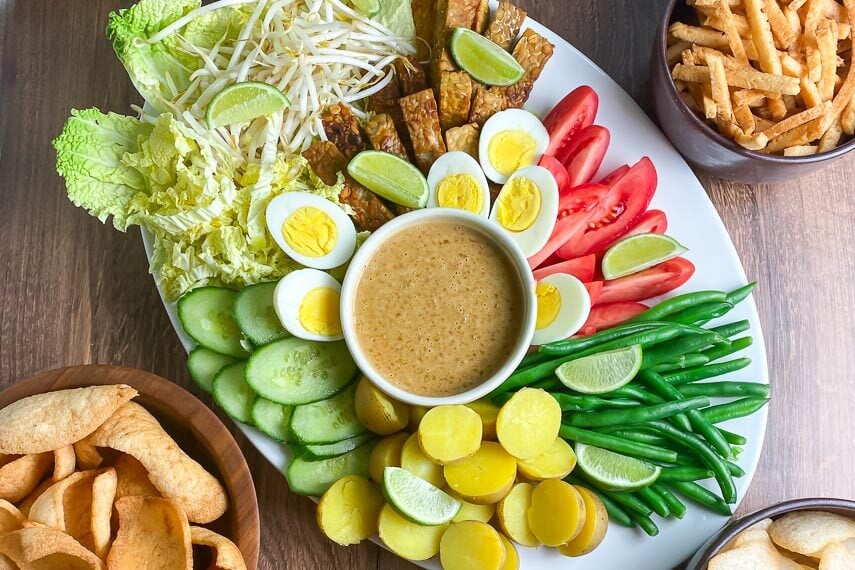
Our version includes tempeh. Gado-Gado is always very vegetable-centric, featuring both raw and steamed vegetables, and peanut sauce in always offered. Crisp shrimp crackers are a traditional accompaniment. On a hot day, this makes a great meal, and it should be served room temperature, but not cold.
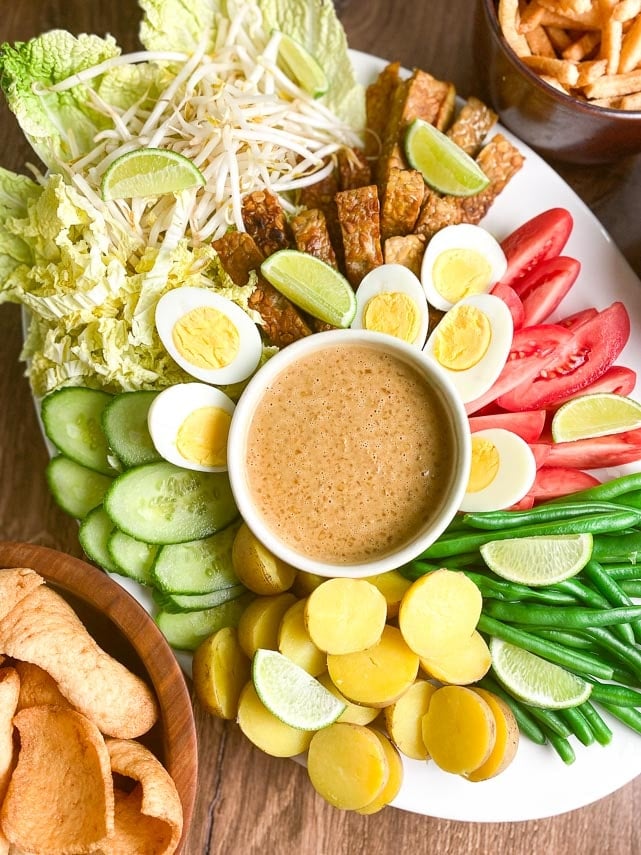
Plant-Based Cooking & Eating
We are adding more and more plant-focused recipes. What does this mean? Plant-based is not vegan or even vegetarian. It just means adding more plant-based foods to your diet. Maybe you are an omnivore, but have meatless Mondays? Or maybe you have cut out red meat, but still eat other animal-based proteins, and your focus is on the vegetables, grains and legumes in your diet? All of these approaches can be accomplished while eating low FODMAP. Our Low FODMAP Gado-Gado is a perfect example of this approach.
Gado-Gado peanut sauce sometimes includes shrimp paste (terasi), and certainly the shrimp crackers on the side along with the abundance of steamed and raw vegetables make Gado-Gado vegetable centric, but neither vegetarian nor vegan.
For more information on veganism, check out our Vegan Series. (And our upcoming Plant-Based series).
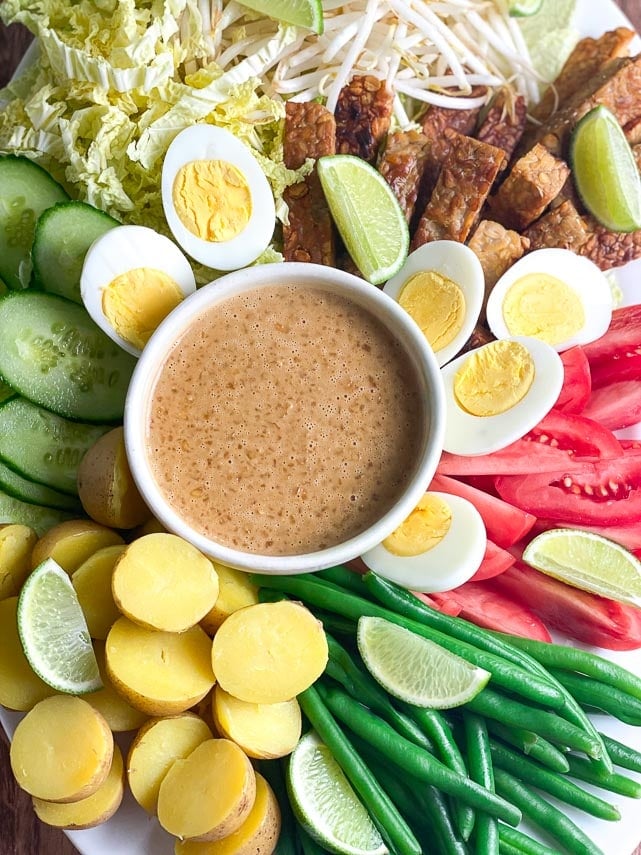
Frequently Asked Questions
Gado-Gado is a plant focused composed salad that always includes a peanut dressing and an assortment of fresh and cooked vegetables. It hails from Indonesia and is considered a national dish. Versions will vary depending on the cook, but steamed potatoes, hardboiled eggs, cabbage, cucumber and long beans are popular. Tofu or tempeh are often included.
Tempeh is a fermented soybean product. It is firmer than tofu and has much more texture. It has a definite flavor – more so than tofu. Some folks love it, while for others it is an acquired taste, and then there are people who would rather not eat it.
Like any food product, there are great versions, ones that are just OK, and poor renditions as well. I have a new neighbor, Levina Soetyono, who is from Indonesia and she guided me through many parts of this recipe. Levina makes her own tempeh, with starter culture that she brought from her homeland. She made us fresh tempeh, and it was simply the best I have ever had.
When shopping for tempeh, read labels and get “plain” tempeh as some might be flavored with high FODMAP ingredients, or ingredients that just do not belong in this dish.
Levina says when tempeh is freshly made, it needs no further cooking, however, since 99.9% of you (100%?) will be using purchased tempeh, a quick steam is helpful. Steaming tempeh removes some bitterness and prepares it for what is to come – in this case a quick sauté. All of you will sauté it until golden and a bit crisp on the outside. Directions in recipe itself, below.
This recipe suggests sautéing the tempeh in garlic-infused oil that is based upon a neutral flavored vegetable oil – not olive oil. You have two choices when it comes to infused oils: buy it or make your own. In either case you have choices and I implore you to make or buy one based on a neutral flavored vegetable oil and not olive oil for this dish.
The flavor of olive oil simply does not belong in our Gado-Gado. I always have both kinds of infused oils at hand and will use the olive oil based for Italian and Mediterranean cooking, and neutral oil based for my Asian, Mexican and Tex-Mex cooking.
We have a recipe for homemade, of course, or try the Tourangelle, based upon sunflower oil.
The peanut sauce is a key feature of Gado-Gado and every cook will have their own take in terms of flavor and what ingredients are used. My Indonesian friend Levina says the one thing you should never do is start with peanut butter; she says you must start with peanuts themselves. She says that too many versions create a thick, sticky, gloppy sauce and that is not what it is supposed to be.
Yes, many Internet recipes use peanut butter, but she is the native Indonesian, so I am listening to her. Ultimately the sauce should be pourable and flowable, but have texture from the freshly ground peanuts. It does thicken upon standing and can be resuscitated with more coconut milk and/or water.
Gado-Gado peanut sauce often includes the aforementioned coconut milk, ketjap manis, palm sugar, chiles or sambal oelek, lots of garlic, lime juice, shrimp paste (terasi) and tamarind. Our version is a bit streamlined and contains ground peanuts, canned coconut milk, ketjap manis, sambal oelek, lime juice, FreeFod Garlic Replacer and water.
Yes, you have to use fresh peanuts. Levina says so. If you want to use peanut butter, use freshly ground or at the very least, a natural chunky style – but at least try the freshly ground once. For Levina and me.
Luckily for us, Monash University has lab tested ketjap manis, also known as sweet soy sauce, and it has a low FODMAP serving size of 1 Australian tablespoon. It has the texture of cold maple syrup – thick but pourable. It tastes like a sweet, thick soy sauce and adds a unique flavor.
We consider this specialty ingredient a must for our Low FODMAP Gado-Gado.
In this recipe there really is no substitute. FreeFod Garlic Replacer is a lab tested and certified low FODMAP product that adds garlic flavor to your dishes when you do not want oil (from garlic-infused oils).
The product goes a long way and I think it belongs in everyone’s spice cabinet. It’s flavor, easy, intuitive usage, and lack of salt as a binder makes it a most versatile garlic flavoring agent.
Shrimp crackers, also known as kerupuk udang, are a crunchy accompaniment to Gado-Gado, and they are a great snack in general. Ingredients vary but they are often very simple: tapioca flour, shrimp, sugar, salt and egg. Some versions have additional ingredients, such as MSG, which is not a FODMAP issue.
You have two choices: you can buy them ready-to-eat, or you can buy the kind that you have to cook. Levina strongly suggests the latter. Besides, they cook quickly, and it is really fun to watch them puff up. They expand to sizes much greater than their raw state.
The Komodo brand is beloved and easy to find online. There are big flat ones (sort of like round discs) and also ones that are stick-shaped, and look like French fries, which Levina prefers. I took pics for you of all of them below. Choose whichever you like.
Taste wise I do prefer the ones you have to cook, but I couldn’t decide which shape I liked best.
Below you can see the package of the kind I prefer; you do have to cook these. They are fried in hot oil and the cooking goes quickly.
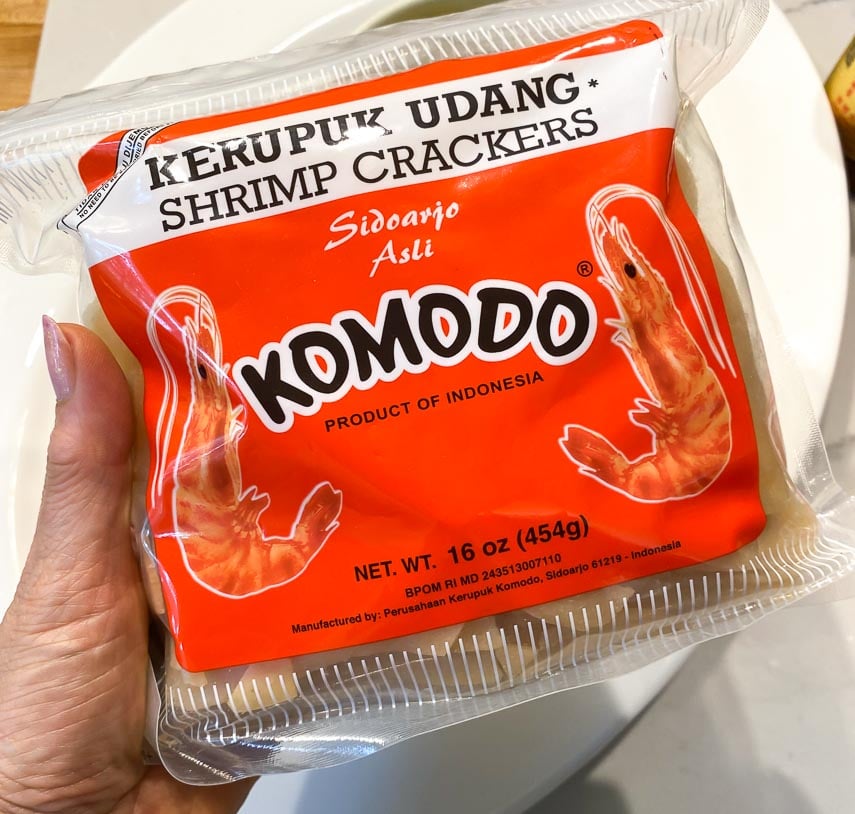
The ingredients are low FODMAP, gluten-free and very simple.
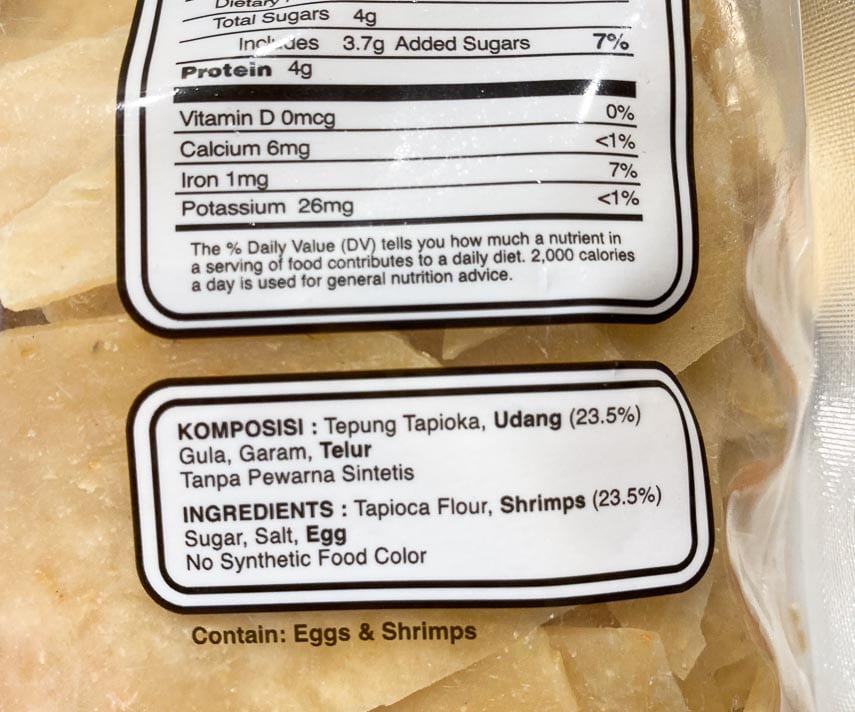
This is what they look like in the bag. Some will be broken, but don’t worry. They cook up into odd shapes anyway.
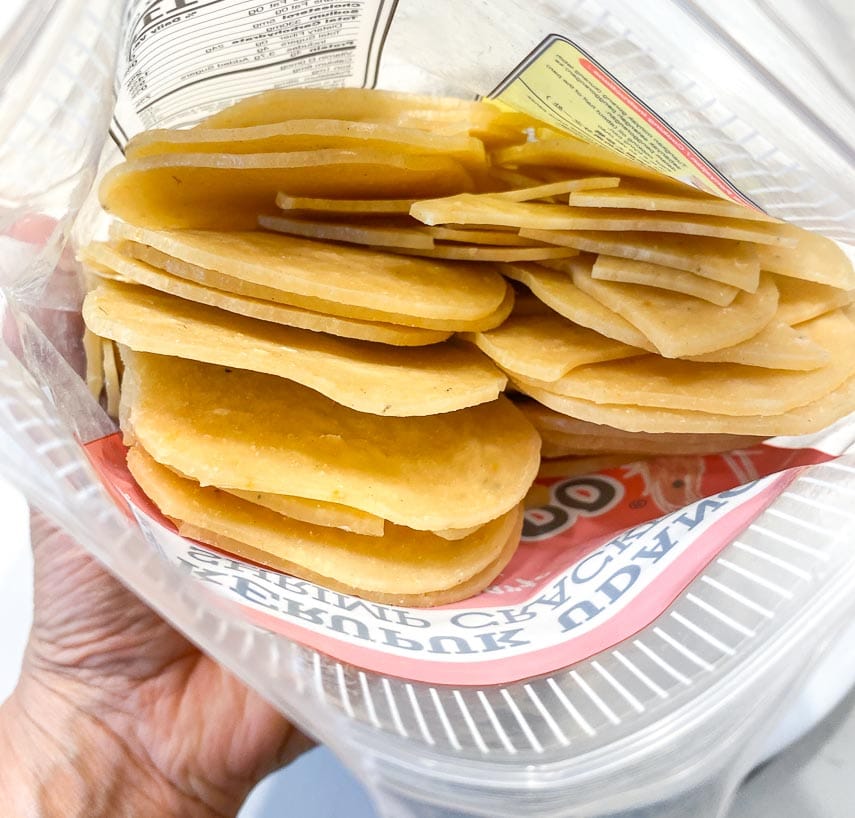
You can see that they are sort of round.
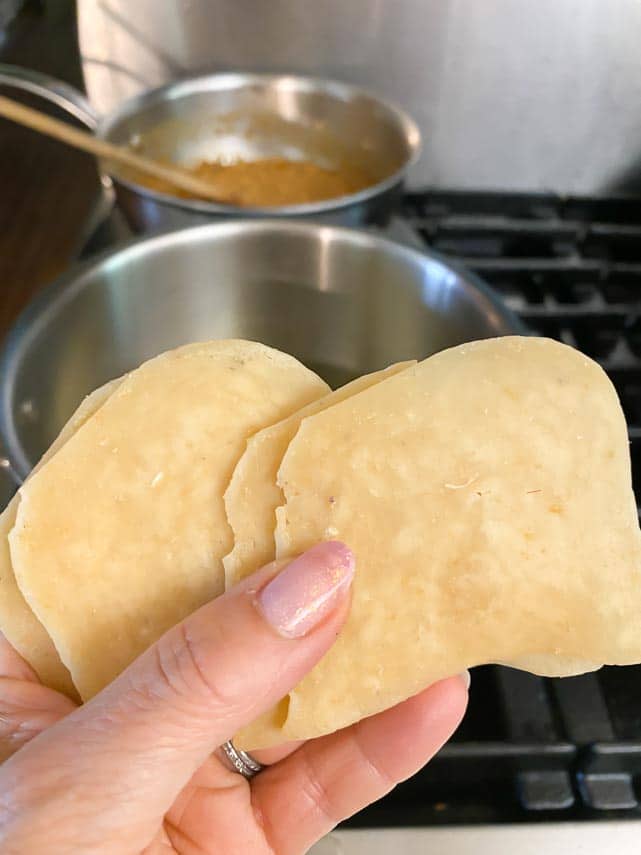
The ones below are the stick-style that Levina prefers.
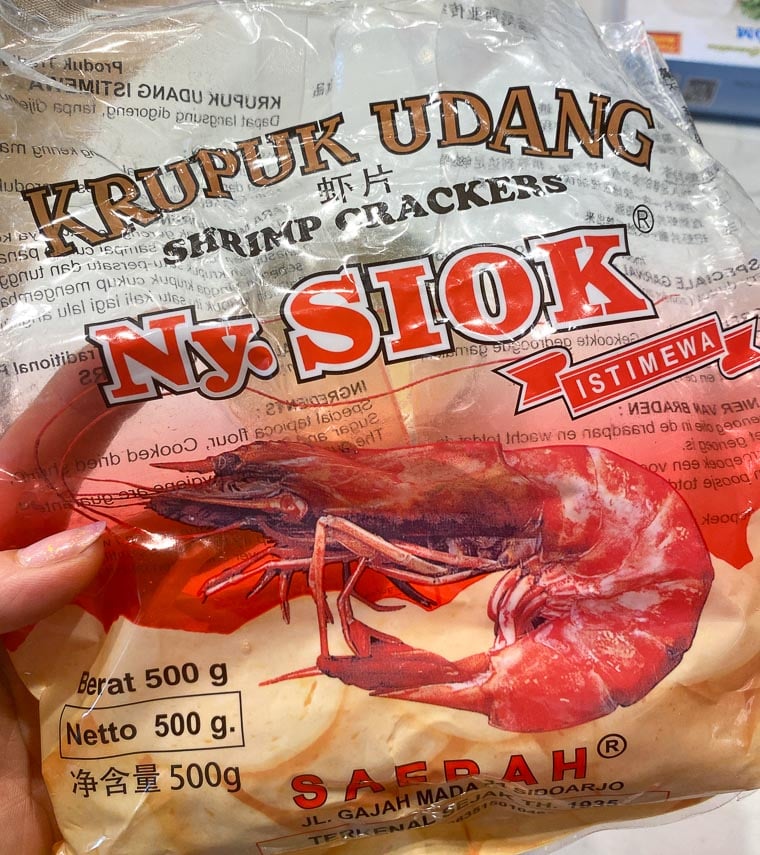
The graphic below shows the 3 styles: stick-style, disc style and ready-to-eat.
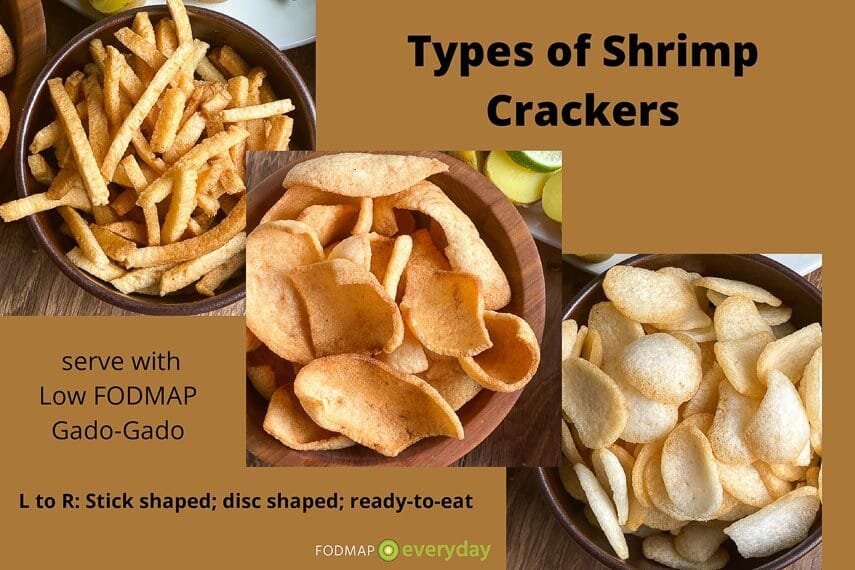
How To Make Low FODMAP Gado-Gado
For the Salad: Place a steamer insert in a large pot and add a few inches of water to come to a level below the insert. Add tempeh, cover, bring to a simmer and cook for 12 minutes. Use tongs to gently remove tempeh and set aside.
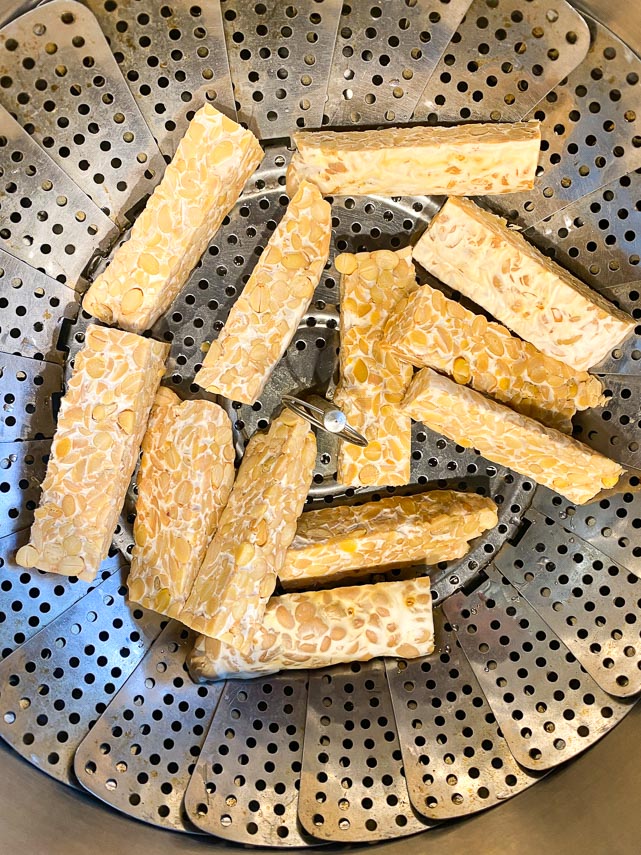
Using same pot and steamer insert, add the potatoes and steam until tender, about 15 minutes. Check water level and top off as needed. Remove potatoes and set aside. Halve them when cooled.
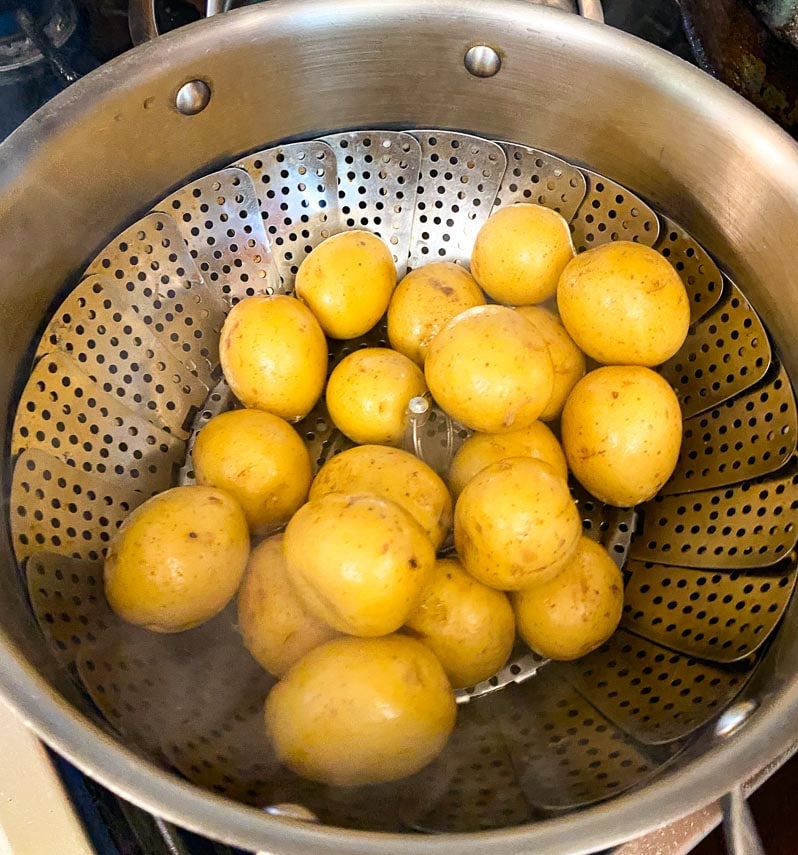
Using same pot and steamer insert, add the green beans and steam until just tender, but still very bright green, about 5 minutes. Remove and place in ice water to cease cooking.
While the potatoes and beans are steaming, sauté your tempeh. Heat the oil in a skillet over medium heat. Add tempeh, season with salt and pepper, and cook until golden brown on each side, abut 5 minutes total; set aside when done.
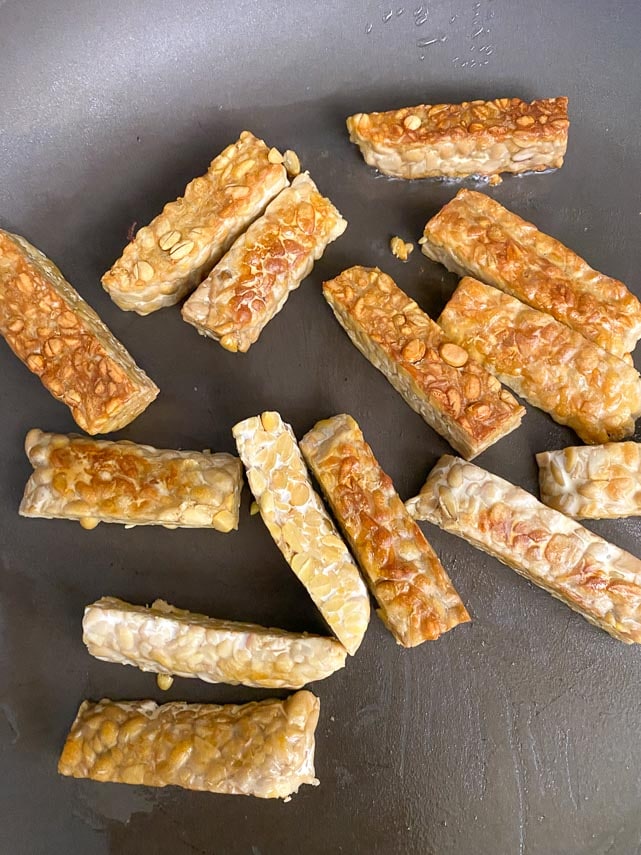
For the Sauce: Whisk together the water and FreeFod Garlic Replacer in a medium-sized saucepan until dissolved; set aside.
Grind the peanuts in a food processor fitted with a metal blade until finely ground. There might be some peanut dust and some larger pieces; that is exactly what you want.
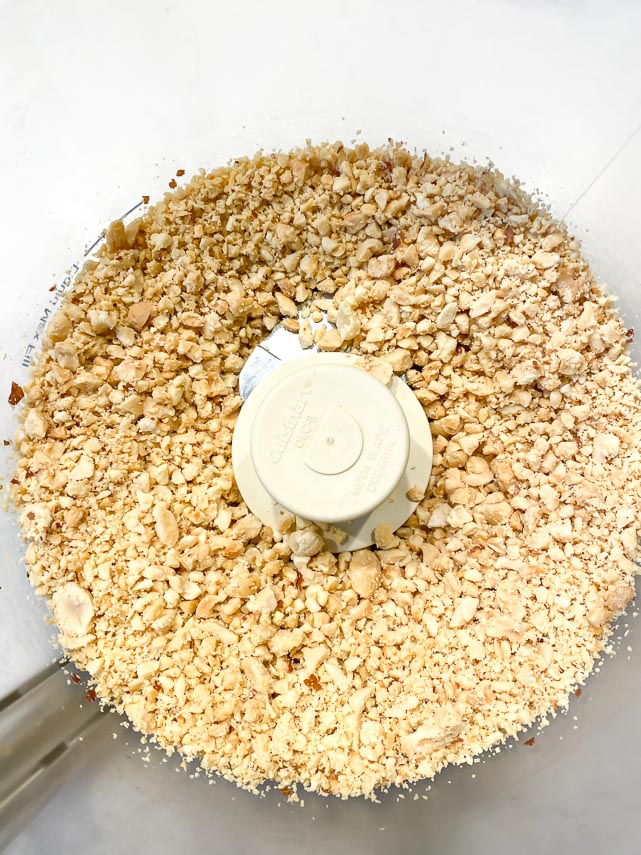
Scrape into the saucepan and then also add the ¾ cup (180 ml) coconut milk, 2 tablespoons ketjap manis, 2 tablespoons lime juice and ½ teaspoon sambal.
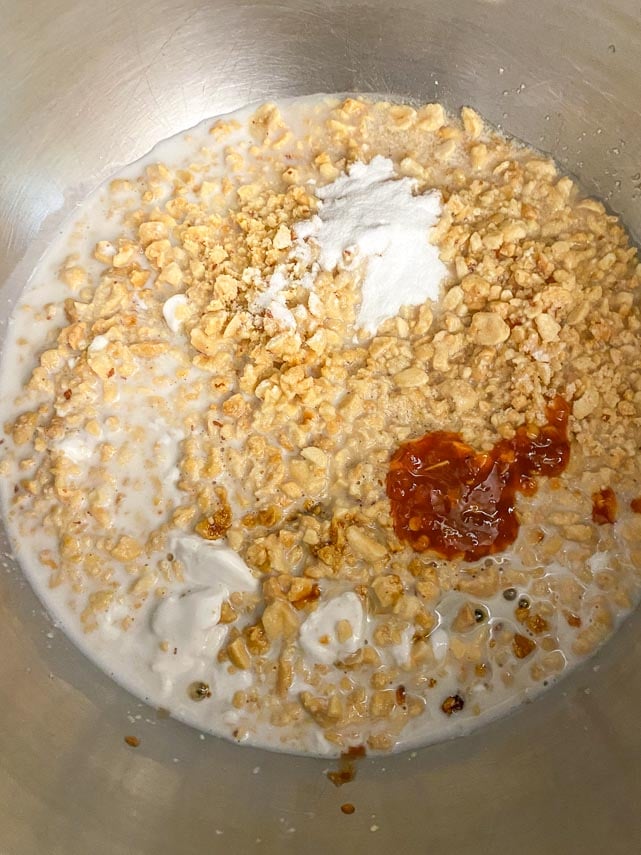
Heat over low-medium heat and cook, stirring often, until combined and thickened a little bit, just a few minutes.
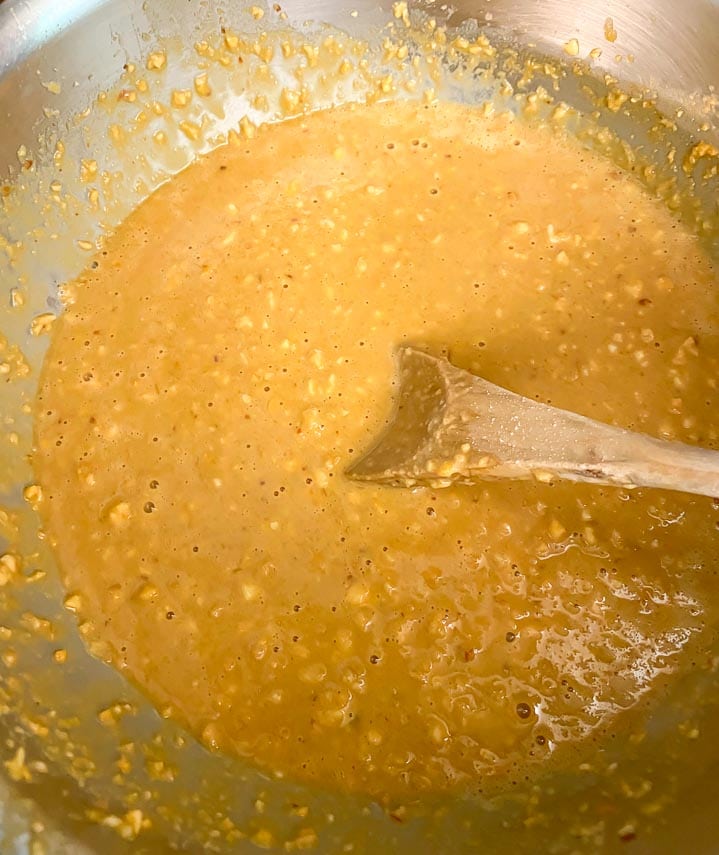
Remove sauce from heat and cool to room temperature. You can see the texture below: there is nubby texture from the peanuts, but it is flowable. It is not sticky or gloppy, which can happen when you begin with peanut butter.
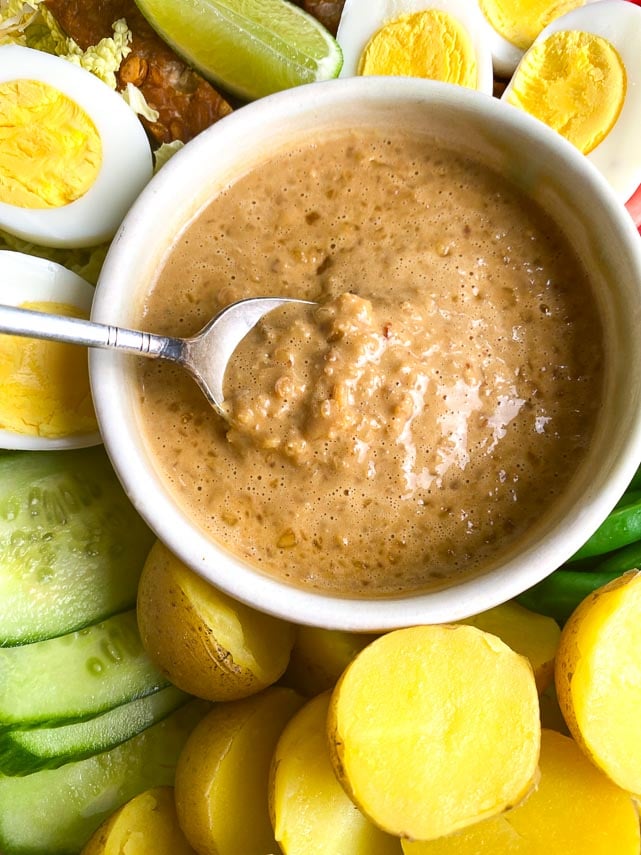
Assembly: On a large platter arrange the cooled cooked vegetables, tempeh and raw vegetables. Give the sauce one last stir, taste and adjust flavor and texture as desired by adding more of the needed ingredient – water and/or coconut milk to thin it out; more sambal for heat; more lime for acidity, etc. Your Low FODMAP Gado-Gado is ready to serve; set out shrimp crackers alongside. Encourage diners to take what they like and top with peanut sauce.
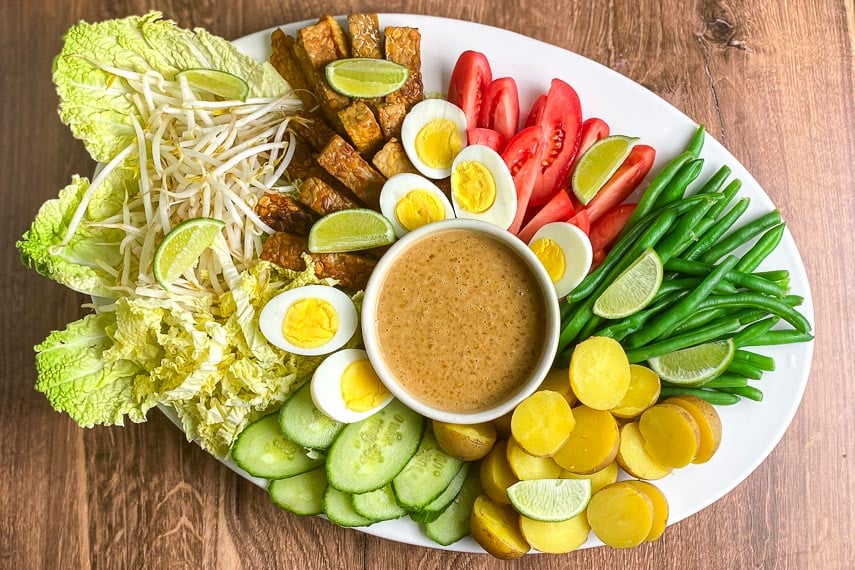
FODMAP Information
Our recipes are based on Monash University and FODMAP Friendly science.
- Cabbage: Both Monash University and FODMAP Friendly have lab tested various cabbages and reported their low FODMAP serving sizes. According to Monash Green Cabbage is low FODMAP in amounts of 75 g (¾ cup) and Red cabbage is low FODMAP in amounts of 75 g (¾ cup). According to Monash Savoy cabbage is low FODMAP in amounts of 40 g (½ cup). According to FODMAP Friendly Savoy cabbage is low FODMAP in amounts of 75 g (1 cup). According to both Monash and FODMAP Friendly, Napa cabbage is low FODMAP in amounts of 75 g (1 cup).
- Coconut Milk: Both Monash University and FODMAP Friendly has lab tested coconut milk for FODMAPs. Monash divides their testing into a few categories. Here are Monash’s statements: Coconut milk with inulin is Red Light high FODMAP at ½ cup (125 ml) or 120 g. There is no information on smaller amounts. UHT (long life, shelf-stable) coconut milk is Green Light low FODMAP at ¾ cup (180 g). Canned coconut milk is Green Light low FODMAP at ¼ cup or 60 g. They also have some brands represented, such as Sanitarium, and their unsweetened coconut milk, which is a shelf-stable type, is low FODMAP at 1 cup (250 g). FODMAP Friendly gives coconut milk a “Fail” at 4-ounces (125 ml) but we do not know what kind they tested. There are a few things to note. First of all, the FODMAP content obviously varies greatly depending on type of processing. Also, although “lite” or “light” canned coconut milk has not been tested, it is the same as canned but with a higher water content, so you can use the canned coconut milk amounts designated and know that you are within low FODMAP serving sizes.
- Cucumbers: Both Monash University and FODMAP Friendly have lab tested cucumbers. FODMAP Friendly gives them a “Pass” at ½ cup (64 g). Monash states that no FODMAPs were detected upon lab testing and set a serving size at ½ cup (75 g).
- Eggs: Eggs are high in protein and do not contain carbohydrates, according to Monash University.
- Garlic-Infused Oil: Make your own Garlic-Infused Oil or buy a commercial equivalent for the easiest way to add garlic flavor to your food. Fructans in garlic are not oil-soluble, so garlic-infused oil is low FODMAP.
- Green Beans: Green beans have been lab tested by both FODMAP Friendly and Monash University. FODMAP Friendly gives them a “Pass” at 75 g, which they say is about 14 beans. Monash gives them a Green Light low FODMAP serving size of 75 g or 15 beans.
- Lime Juice: Monash University has lab tested lime juice and it is low FODMAP in 1 cup (250 g) amounts (double that of lemon juice, as an interesting fact).
- Peanuts: Monash has lab tested peanuts. They are low FODMAP in 28 g amounts, which they say is 32 nuts (but sizes can vary, so go by weight). They state say that only trace amounts of FODMAPs have been found in peanuts.
Please always refer to the Monash University & FODMAP Friendly smartphone apps for the most up-to-date lab tested information. As always, your tolerance is what counts; please eat accordingly. The ultimate goal of the low FODMAP diet is to eat as broadly as possible, without triggering symptoms, for the healthiest microbiome.
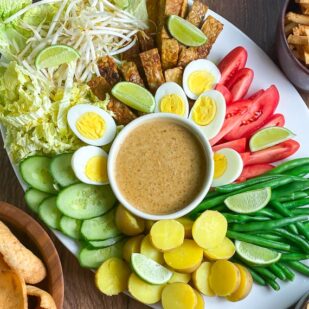
Low FODMAP Gado-Gado
Behold our Low FODMAP Gado-Gado! Sometimes spelled Gado Gado without the hyphen, this composed salad is a national dish in Indonesia. The term “gado-gado” translates as “mix mix” and this refers to the fact that the dish is made up of a mixture of items, which can vary chef to chef, and household to household. Our version includes tempeh. Gado-Gado is always very vegetable-centric, featuring both raw and steamed vegetables, and peanut sauce in always offered. Crisp shrimp crackers are a traditional accompaniment. On a hot day, this makes a great meal, and it should be served room temperature, but not cold.
Ingredients:
Salad:
- 8- ounces (225 g) plain tempeh, cut into finger shapes or wedges
- 1- pound (455 g) small thin skinned waxy potatoes
- 8- ounces (225 g) fresh green beans
- 2 tablespoons Low FODMAP Garlic-Infused Oil, made with vegetable oil, or purchased equivalent
- Kosher salt
- Freshly ground pepper
- 3- plum tomatoes, or equivalent amount beefsteak tomatoes, cored and cut into wedges
- 3 hardboiled large eggs, peeled and halved
- 2 cups (200 g) mung bean sprouts
- 2 cups (150 g) shredded Napa cabbage
- Half a hothouse cucumber, sliced thinly on the diagonal
- Lime wedges
Peanut Sauce:
- ¼ cup (60 ml) water
- 2 teaspoons FreeFod Garlic Replacer
- 10- ounces (280 g) unsalted freshly roasted peeled peanuts
- ¾ cup (180 ml) canned coconut milk, full-fat and well-stirred, or as needed
- 2 tablespoons ketjap manis; (I use ABC brand) or to taste
- 2 tablespoons freshly squeezed lime juice, or to taste
- ½ teaspoon sambal oelek, or to taste
- Salt
- Shrimp crackers, ready-to-eat or cooked per package instructions
Preparation:
-
For the Salad: Place a steamer insert in a large pot and add a few inches of water to come to a level below the insert. Add tempeh, cover, bring to a simmer and cook for 12 minutes. Use tongs to gently remove tempeh and set aside.
-
Using same pot and steamer insert, add the potatoes and steam until tender, about 15 minutes. Check water level and top off as needed. Remove potatoes and set aside. Halve them when cooled.
-
Using same pot and steamer insert, add the green beans and steam until just tender, but still very bright green, about 5 minutes. Remove and place in ice water to cease cooking.
-
While the potatoes and beans are steaming, sauté your tempeh. Heat the oil in a skillet over medium heat. Add tempeh, season with salt and pepper, and cook until golden brown on each side, abut 5 minutes total; set aside when done.
-
For the Sauce: Whisk together the water and FreeFod Garlic Replacer in a medium-sized saucepan until dissolved; set aside.
-
Grind the peanuts in a food processor fitted with a metal blade until finely ground. There might be some peanut dust and some larger pieces; that is exactly what you want. Scrape into the saucepan and then also add the ¾ cup (180 ml) coconut milk, 2 tablespoons ketjap manis, 2 tablespoons lime juice and ½ teaspoon sambal. Heat over low-medium heat and cook, stirring often, until combined and thickened a little bit, just a few minutes. Remove from heat and cool to room temperature.
-
Assembly: On a large platter arrange the cooled cooked vegetables, tempeh and raw vegetables. Give the sauce one last stir, taste and adjust flavor and texture as desired by adding more of the needed ingredient – water and/or coconut milk to thin it out; more sambal for heat; more lime for acidity, salt etc. Your Low FODMAP Gado-Gado is ready to serve; set out shrimp crackers alongside. Encourage diners to take what they like and top with peanut sauce.
Notes:
FODMAP Information
Our recipes are based on Monash University and FODMAP Friendly science.
• Cabbage: Both Monash University and FODMAP Friendly have lab tested various cabbages and reported their low FODMAP serving sizes. According to Monash Green Cabbage is low FODMAP in amounts of 75 g (¾ cup) and Red cabbage is low FODMAP in amounts of 75 g (¾ cup). According to Monash Savoy cabbage is low FODMAP in amounts of 40 g (½ cup). According to FODMAP Friendly Savoy cabbage is low FODMAP in amounts of 75 g (1 cup). According to both Monash and FODMAP Friendly, Napa cabbage is low FODMAP in amounts of 75 g (1 cup).
• Coconut Milk: Both Monash University and FODMAP Friendly has lab tested coconut milk for FODMAPs. Monash divides their testing into a few categories. Here are Monash’s statements: Coconut milk with inulin is Red Light high FODMAP at ½ cup (125 ml) or 120 g. There is no information on smaller amounts. UHT (long life, shelf-stable) coconut milk is Green Light low FODMAP at ¾ cup (180 g). Canned coconut milk is Green Light low FODMAP at ¼ cup or 60 g. They also have some brands represented, such as Sanitarium, and their unsweetened coconut milk, which is a shelf-stable type, is low FODMAP at 1 cup (250 g). FODMAP Friendly gives coconut milk a “Fail” at 4-ounces (125 ml) but we do not know what kind they tested. There are a few things to note. First of all, the FODMAP content obviously varies greatly depending on type of processing. Also, although “lite” or “light” canned coconut milk has not been tested, it is the same as canned but with a higher water content, so you can use the canned coconut milk amounts designated and know that you are within low FODMAP serving sizes.
• Cucumbers: Both Monash University and FODMAP Friendly have lab tested cucumbers. FODMAP Friendly gives them a “Pass” at ½ cup (64 g). Monash states that no FODMAPs were detected upon lab testing and set a serving size at ½ cup (75 g).
• Eggs: Eggs are high in protein and do not contain carbohydrates, according to Monash University.
• Garlic-Infused Oil: Make your own Garlic-Infused Oil or buy a commercial equivalent for the easiest way to add garlic flavor to your food. Fructans in garlic are not oil-soluble, so garlic-infused oil is low FODMAP.
• Green Beans: Green beans have been lab tested by both FODMAP Friendly and Monash University. FODMAP Friendly gives them a “Pass” at 75 g, which they say is about 14 beans. Monash gives them a Green Light low FODMAP serving size of 75 g or 15 beans.
• Lime Juice: Monash University has lab tested lime juice and it is low FODMAP in 1 cup (250 g) amounts (double that of lemon juice, as an interesting fact).
• Peanuts: Monash has lab tested peanuts. They are low FODMAP in 28 g amounts, which they say is 32 nuts (but sizes can vary, so go by weight). They state say that only trace amounts of FODMAPs have been found in peanuts.
Please always refer to the Monash University & FODMAP Friendly smartphone apps for the most up-to-date lab tested information. As always, your tolerance is what counts; please eat accordingly. The ultimate goal of the low FODMAP diet is to eat as broadly as possible, without triggering symptoms, for the healthiest microbiome.
Nutrition
All nutritional information is based on third-party calculations and should be considered estimates. Actual nutritional content will vary with brands used, measuring methods, portion sizes and more. For a more detailed explanation, please read our article Understanding The Nutrition Panel Within Our Recipes.
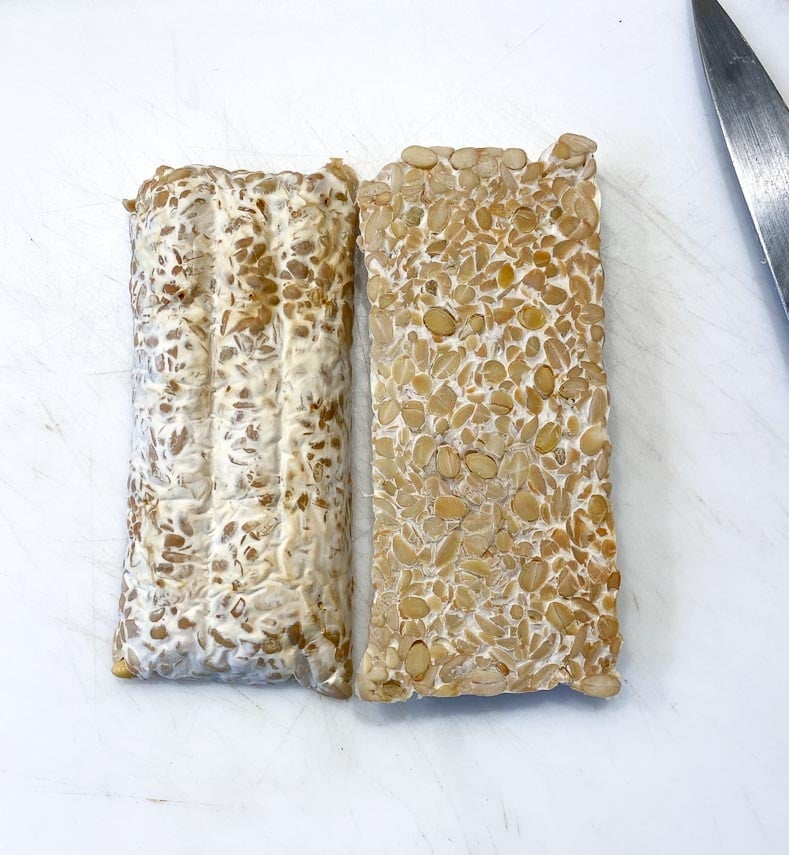
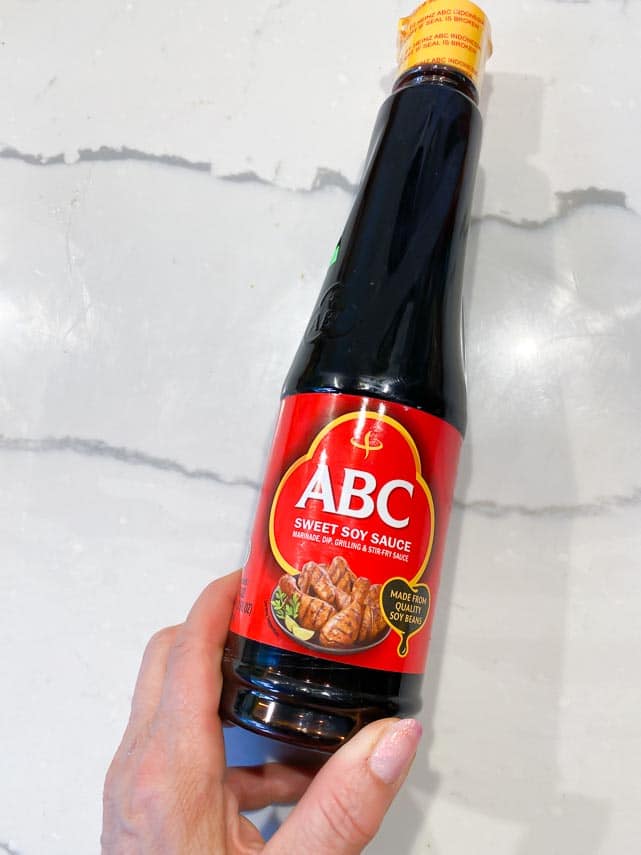
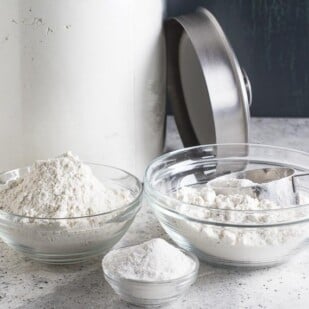
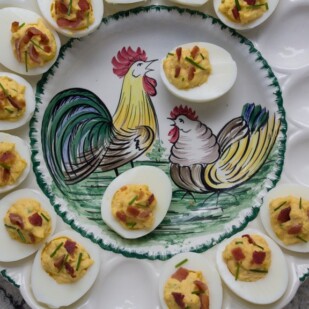






I’m low FODMAP, but I live with a child w/ a severe peanut allergy. Any peanut-free substitutes?
Hi there! Because gado-gado is very much about the peanut sauce I have never tried to create a stand in substitute. I would suggest choosing another dish since this is so peanut focused. On the other hand if you wanted to take the concept of fresh and cooked vegetables and serving them with some sort of dip that does work for you, why not? It wouldn’t be gado-gado But it might be delicious.
If cashew nut is non allergic you can subtitute peanut with it.
Also, for for gado gado or other indonesian peanut dressing dish, a 80% peanut 20% cashew will give extra flavor.
The addition of cashews sounds really interesting however the only cashews that would work within the parameters of the diet would be activated cashews also known as sprouted cashews. Around 10 nuts would be considered diet compliant where as regular cashews do not have a Low FODMAP diet serving size, FYI. If you know that you can tolerate cashews then by all means include them.
We can’t have fresh tomatoes though.
I am not sure what you mean. From a FODMAP perspective there are low FODMAP allowances of all kinds of tomatoes.
Traditionally speaking, are the potatoes and green beans eaten warm, or cooled down?
At my house, by the time I finished with the other preparations, they’d probably be room temperature… but I just wondered how Levina does it!! 🙂
I will write her and ask! Stay tuned. EDIT: She wrote back right away: “In Indonesia, most of our foods are served at room temperature, including Gado-Gado”.